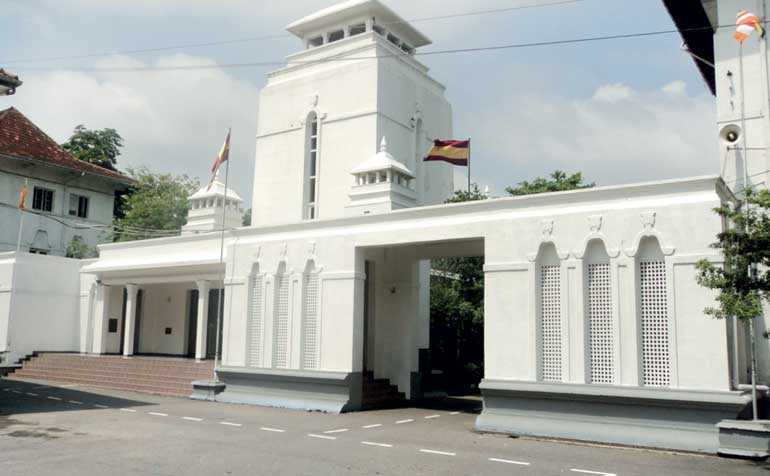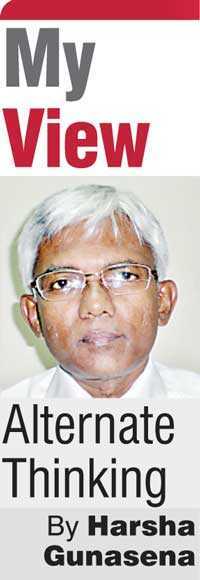Saturday Apr 19, 2025
Saturday Apr 19, 2025
Tuesday, 9 October 2018 00:00 - - {{hitsCtrl.values.hits}}

Ananda College, Colombo
In 2011, when Ananda College Colombo celebrated its 125th anniversary, having gone through the contributions made by non-Sinhalese and non-Buddhists towards building up the great school, it was decided to have an annual encounter of cricket between Ananda College and Jaffna Hindu College (JHC) named after V.T.S. Sivagurunathan, a distinguished teacher of Ananda and an alumni of JHC. Thilak Karunarathne was the President of Ananda College OBA at that time.
This encounter was happening annually since 2012 in both the venues Colombo and Jaffna in turns. Recently a debate between the two schools was started and named after V. Thanabalasingham and Panikkar, teachers of Ananda College. Encounters of chess and basketball were also added to the annual festival.
The annual program of 2018 was held in Colombo on 28 and 29 September. In this article I try to revisit the evolution of the concept of Sinhala Buddhism in relation to Ananda College, which was at the fore front of the struggle against the colonialism and in favour of the Buddhist education in Sri Lanka which was suppressed by the colonial masters.
The legendary Principal of Ananda College, P.De S. Kularatne (1893-1976) took up the reins of the great school in 1918, three years after the Sinhala- Muslim riots. He was the Principal of Ananda for 22 years in three spells from 1918-1923, 1923-1932 and 1936-1943.
Kularatne’s vision for Ananda 
Kularatne’s vision for Ananda was essentially anti-colonial and pro-Ceylonese. It was not confined to Sinhala Buddhism. He was very critical of the step motherly treatment the Buddhist education in Sri Lanka received at the hands of the British Christian Government and acted against it. However, he was not anti-Christian. He has not taken a separatist stand in favour of Sinhalese against the ethnic Tamils, Muslims or Burghers. He was for a United Ceylonese Nation.
“The Jaffna Youth Congress (JYC) that had its origins in 1924, invited Ananda College Principal P. de S. Kularatne to be the Chair at its second annual sessions. Kularatne was reported to have ‘kept the visionary youth spellbound with his speech for more than an hour. He underlined the three aims of the Congress: To revive national art, literature and music; to make Ceylon economically independent, to train the young for national service in particular and to work for the realisation of the ideal of a United Ceylonese Nation’.” (Kumudini Hettiarachchi, Sunday Times, 12 November 2012)
“In 1922 in addition to 1084 Buddhists, there were 83 Hindus, 47 Muslims, 27 Protestant Christians, and 16 Roman Catholics among the pupils. Ananda provided religious training for non-Buddhists as well. Muslim and Hindu boys were taught Islam and Hinduism respectively. The number of Christian students at Ananda was very small. Had there been a sufficient number Kularatne would certainly have arranged for their religious instruction as he had done for Muslims and Hindus said de Lanerolle. He found one Christian boy in the hostel and arranged for him to attend church on Sundays. (‘Kularatne of Ananda’ by Kamalika Pieris, page 53).
“Ananda College had foreign students too. Around 1922, about 25 to 40 boys from Burma joined Ananda as boarders.” (ibid page 59).
“Ananda had Tamil pupils and past pupils recall that Kularatne started teaching Tamil to the Sinhalese boys and Sinhala to the Tamil boys….The school magazine had a section in Tamil and by 1939 there were separate Sinhala and Tamil sections with separate editorials as well…. Kularatne observed ‘Ananda has encouraged the study of our own languages when other schools despised them’.” (ibid page 72)
“Kularatne took the view that it was Pali and Sanskrit that should be taught as classical languages in Ceylon, not Latin and Greek.” (ibid page 74)
“Kularatne on the other hand, deliberately introduced a ‘national’ component to Ananda. Ananda College embraced both western and local cultures with equal enthusiasm. Ananda taught Buddhism, Pali, Sinhala, Tamil, Ceylon History, udarata netum and fresco painting together with the western curriculum and showed, in the process, that it was possible to combine indigenous culture and western education in the same school without affecting academic performance.” (ibid page 101)
“Kularatne wanted to develop independent minded students capable of challenging the colonial mind set…. Students joining Ananda from other public schools were amazed at the spirit of patriotism openly and boldly displayed by the students and the staff.” (ibid page 105)
“Kularathne was a firm supporter of denominational schools. His position was that if denominational schools are to exist, all denominations must be allowed and all denominations must be encouraged to establish schools for their followers…Kularatne has encouraged T.B.Jayah to leave Ananda and take over Zahira College, Colombo…When denominational schools were taken over by the government in 1960, Kularatne wished to see a religious atmosphere in state schools, where from the principal downwards there was respect for all religions.” (ibid Page 186, 187)
Kularatne chaired Ceylon National Congress while he was the Principal of Ananda. As the Chair he demanded full independence for Ceylon. “So long as they gained their independence, Kularatne did not care which community ruled the country. He did not mind if they had a cabinet composed of entirely of Tamils or entirely of Muslims.” (ibid page 254)
Promotion of Sinhala Buddhism
After Kularatne’s retirement in 1943, A.B. Perera was the Principal for a short period and then L.H. Mettananda (1894-1967) took over and led Ananda from 1945-1954. Prior to that Mettananda was the Principal of Ananda from 1932-1936, when Kularatne was away from Ananda to head Dharmaraja College, Kandy. Mettananda, hailing from Ambalangoda as Kularatne, was one of the trio along with Kularatne who influenced Ananda mostly. The other person was G.P. Malalasekara, who acted as the principal for a short period in the absence of Kularatne in 1923. All three of them headed the All Ceylon Buddhist Congress at different times while working at Ananda College.
It was during the time of Mettananda, who was an ardent Sinhala Buddhist, that Sinhala Buddhism was promoted in Ananda. During the period Mettananda was the principal of Ananda there was a strong movement to make Sinhala the official language in Ceylon. In 1939 the Ceylon National Congress called for both Sinhala and Tamil to be declared official languages. Yet in 1953, the Chairman of the Official Languages Commission, Arthur Wijeyewardene, said that it was easier to make one language the official language. Both Mettananda and Malalasekara were members of the Official Languages Commission.
“L.H. Mettananda, wearing his other hat as the General Secretary of the ultra-nationalist Lanka Jathika Bala Mandalaya (which roughly translates as Lanka Nationalist Activist Forum), threatened to launch a countrywide ‘sathyagraha’ campaign if the Government refused to make Sinhala the only official language” (‘Linguistic nationalism, Institutional decay, and ethnic conflict in Sri Lanka’ by Neil De Votta). At this time even Kularatne also was for the Sinhala Only policy at National level.
Sivagurunathan was invited as the Chief Guest of an Ananda prize-giving in 1958, during the time of S.A Wijethilake. He said: “May I remind you all, that you are one and all the proud inheritors of a sacred trust, and it is for you and me, a past servant of hers, to see that Ananda does not become a lifeless State school, is not satisfied with being merely a Sinhalese Buddhist School, but grows into a greater and greater Ananda.” (Kumudini Hettiarachchi, Sunday Times, 12 November 2012)
Ananda remained merely a Sinhala Buddhist school despite the early endeavours of Kularatne on the contrary. His broader foundation of Ananda was eroded gradually. Minister Rajitha Senarathne, delivering a speech at the launch of the biography of Prime Minister Ranil Wickremesinghe written by Dinesh Weerakkody said that Wickremesinghe kept his multi-ethnic and multi-religious Royal College heritage right along, unlike old Anandians like him, so Wickremesinghe is more equipped to give a lasting solution to the ethnic problem of the country.
Need of the hour is different today
The education in this country was with the Pirivenas managed by the Bhikkus. With the arrival of the foreign invaders, education was shifted from the Bhikkus to Christian missionaries. The missionaries used education to promote their religion as well. Kularatne, Malalasekara and Mettananda opposed this. Therefore, they promoted Buddhist education. That was the need of the hour, although Kularatne had a broad-based and far-thinking approach to the problem. The need of the hour is different today.
In the Majjima Nikaya, Alagaddupama Sutta Buddha compared his teachings to a raft used for crossing over a river. “In the same way, monks, have I shown to you the Teaching’s similitude to a raft: as having the purpose of crossing over, not the purpose of being clung to. You, O monks, who understand the Teaching’s similitude to a raft, you should let go even (good) teachings, how much more false ones!” (Translated by Nyanaponika Thera)
Therefore, Sinhala Buddhists should let go of the collective colonial inferiority complex which has plagued the country, hindering creating a ‘Unified Ceylonese Nation’ as Kularatne envisioned.
If they want to promote national harmony, they should take the path cleared by Ananda College with the pioneering linkage with Jaffna Hindu College. Hostilities should be replaced with friendship. Misunderstandings should be replaced with understandings. Complexes should be replaced with wisdom. Misery should be replaced with happiness and thereafter with prosperity.
If they want to promote Buddhism, they should take the following path. As a result of the vipassana meditation techniques, which were brought down from generation to generation, passing down to the laymen by the Burmese and Thai Buddhist meditation masters by way of ten-day meditation retreats, message of mindfulness is spreading in the west.
In the school curricula of UK, Australia and several other countries, mindfulness which is the first step of vipassana meditation is taught today. Most of the Sinhala Buddhists or their militant Bhikkus can’t make head or tail of vipassana meditation. If they go on like this their children will have to learn it from the West. Therefore, they should go to their roots. Merely visiting temples unmindfully and fighting with all the other ethnic and religious groups, is soon becoming outdated.
(The writer was a student and hosteler of Ananda College during the times of M.W. Karunananda, E.A. Perusinghe and G.W. Rajapakse.)
Discover Kapruka, the leading online shopping platform in Sri Lanka, where you can conveniently send Gifts and Flowers to your loved ones for any event including Valentine ’s Day. Explore a wide range of popular Shopping Categories on Kapruka, including Toys, Groceries, Electronics, Birthday Cakes, Fruits, Chocolates, Flower Bouquets, Clothing, Watches, Lingerie, Gift Sets and Jewellery. Also if you’re interested in selling with Kapruka, Partner Central by Kapruka is the best solution to start with. Moreover, through Kapruka Global Shop, you can also enjoy the convenience of purchasing products from renowned platforms like Amazon and eBay and have them delivered to Sri Lanka.
Discover Kapruka, the leading online shopping platform in Sri Lanka, where you can conveniently send Gifts and Flowers to your loved ones for any event including Valentine ’s Day. Explore a wide range of popular Shopping Categories on Kapruka, including Toys, Groceries, Electronics, Birthday Cakes, Fruits, Chocolates, Flower Bouquets, Clothing, Watches, Lingerie, Gift Sets and Jewellery. Also if you’re interested in selling with Kapruka, Partner Central by Kapruka is the best solution to start with. Moreover, through Kapruka Global Shop, you can also enjoy the convenience of purchasing products from renowned platforms like Amazon and eBay and have them delivered to Sri Lanka.